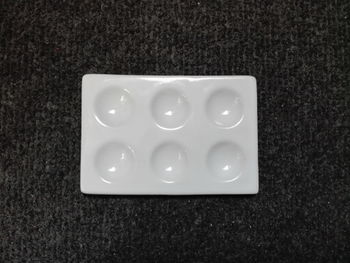Difference between revisions of "Spot plate"
(Created page with "{{Stub}} A glazed ceramic spot plate with 6 wells A '''spot plate''', also called '''reaction plate''', is a laboratory tool used...") |
|||
| Line 5: | Line 5: | ||
==Design== | ==Design== | ||
| − | Spot plates are commonly made of glazed porcelain, though glass and plastic spot plates are also available. Spot plates consist of a flat plate with several potholes (also called cavities or wells), usually 6, 12 or 24. | + | Spot plates are commonly made of glazed porcelain, though sometimes glass and plastic spot plates are also available. Spot plates consist of a flat plate with several potholes (also called cavities or wells), usually 6, 12 or 24. |
Inside these potholes, a drop of reagent is added, and another is added to observe any reaction that might (not) appear. For multiple reactions, add a drop of reagent in each well. | Inside these potholes, a drop of reagent is added, and another is added to observe any reaction that might (not) appear. For multiple reactions, add a drop of reagent in each well. | ||
Revision as of 20:38, 5 June 2018
 |
This article is a stub. Please help Sciencemadness Wiki by expanding it, adding pictures, and improving existing text.
|
A spot plate, also called reaction plate, is a laboratory tool used for qualitative determination of reagents.
Design
Spot plates are commonly made of glazed porcelain, though sometimes glass and plastic spot plates are also available. Spot plates consist of a flat plate with several potholes (also called cavities or wells), usually 6, 12 or 24.
Inside these potholes, a drop of reagent is added, and another is added to observe any reaction that might (not) appear. For multiple reactions, add a drop of reagent in each well.
Availability
Spot plates are sold by chemical suppliers. They can also be bought online.
DIY spot plate
A simple spot plate can be made by heating a rounded metal item like a ball using a heat gun, then pressing the heated metal against a thick flat plastic sheet until a pothole is created. Be warned that this method may not work well on all plastics, some may char, while others may not be compatible with organic solvents. This procedure does not work on glass, as it may crack or deform differently.
Another way is to make a plate out of gypsum or cement, create a few potholes using a metal ball, and then let the gypsum dry. Coat the part with potholes in a chemically resistant coating, like hydrophobic paint or silicone, to obtain an inert surface.
To make a real spot plate, you must first make a plate out of wet clay, then make a few potholes in the plate. Let the clay dry completely, then fire it in a kiln. Coat the plate in chemically resistant glazing, dry it, then fire the glazed plate to finish it. Inspect the spot plate for any defects.
